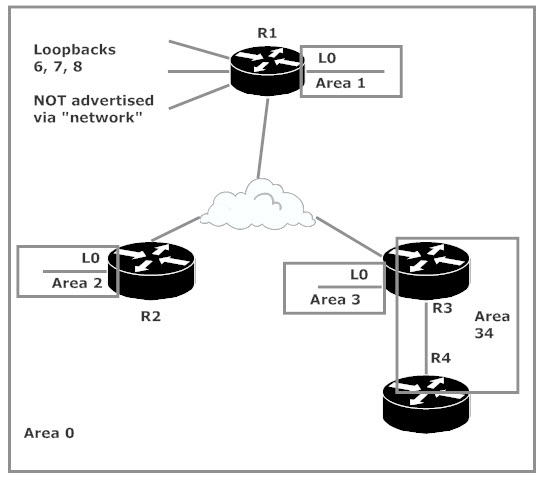CCNP ROUTE OSPF Lab: Route Redistribution And Subnets
Here’s where we were at the end of the first part of this CCNP ROUTE OSPF lab. R4 has a route to every loopback in its OSPF routing table, along with the 172.12.123.0 /24 network, the NBMA network connecting R1, R2, and R3.
Let’s do a little route redistribution on R1 to give us more routes to work with and review an important OSPF concept or three. I’ve added three loopbacks to R1 that are not being introduced to OSPF via the network command. (I’ve also removed the Serial interface names for clarity’s sake, since we’re getting a little crowded here!)
We’ll advertise these routes via the redistribute connected command. There’s one little “gotcha” you need to watch with this command in OSPF. Cisco routers will be kind enough to remind you of this, but Cisco exams probably won’t:
It’s highly unlikely you want only your classful network numbers to be redistributed, so you’ll need to enter the full redistribute connected subnets command. If you’re missing subnets after redistributing routes into OSPF, a missing subnets option is likely the culprit. Beware of OSPF configs where you see only “redistribute connected”!
Performing route redistribution on an OSPF-enabled router makes that route an Autonomous System Border Router (ASBR). Just as with an ABR, you can spot an ASBR with the show ip ospf command. In this case, R1 is both an ABR and and ASBR, which is perfectly legal. Note the redistribution info given right after the ABR/ASBR confirmation.
Let’s go to the far end of the network and see if R4 sees these routes.
The newly redistributed routes are there, marked as O E2 routes, the default route type for routes learned by OSPF via route redistribution.
You know, this table is getting pretty big considering the next-hop address for every route is the same. Before we address that, let’s be sure R4 can ping all three of the new routes.
The pings go right through, so all is well — but it could be better. It’s a real waste of time and router resources for R4 to be continually looking up routes in that table for the best match when the packets are always going to R3 via R4’s FastEthernet interface. This is a great opportunity to use an OSPF stub area to shrink that routing table while keeping it complete — “complete and concise”, as I like to say. (Feel free to steal that.) We’ll put this theory into action in the next part of this lab.
CCNP ROUTE OSPF Lab: Stub Areas In Action










